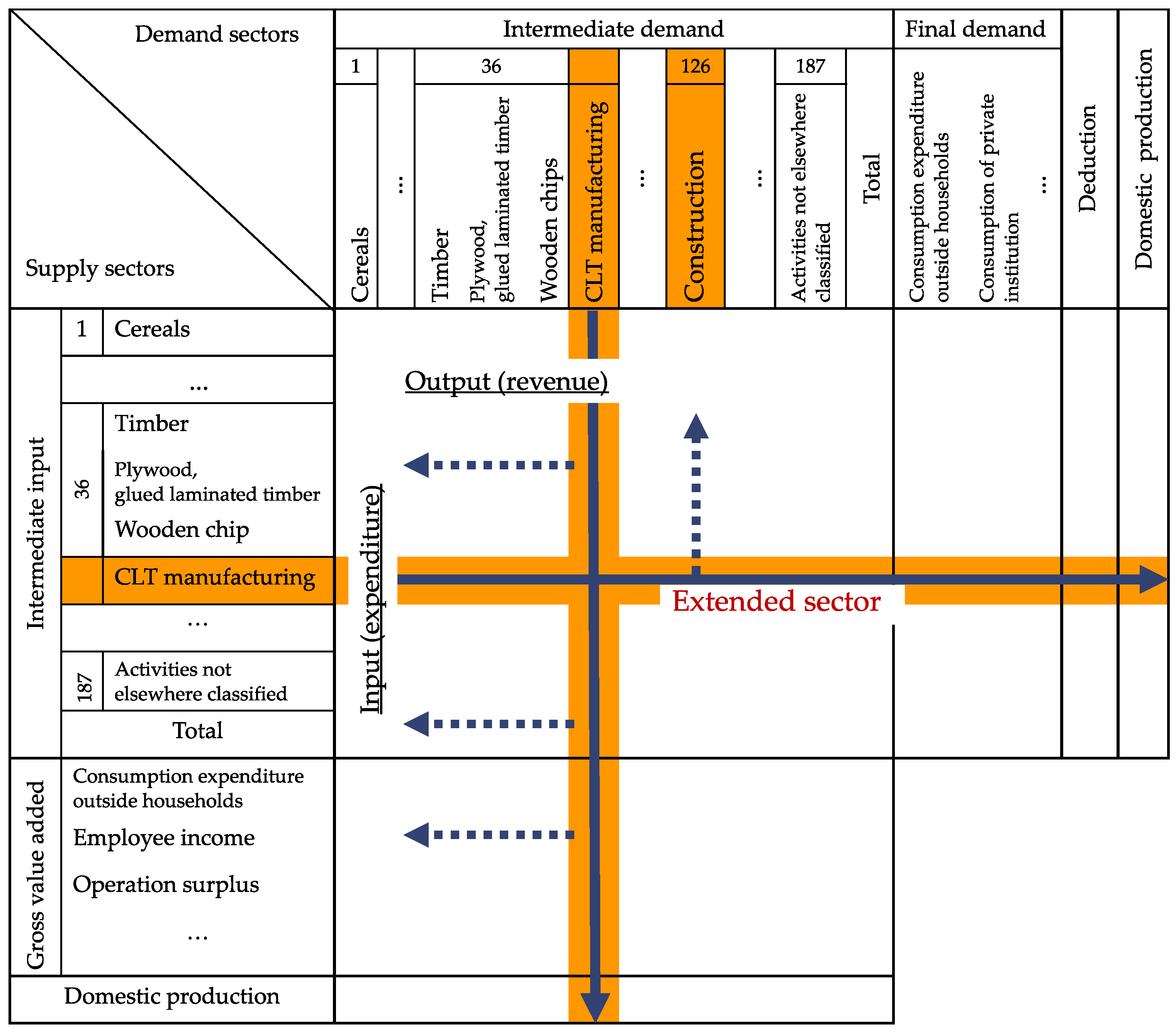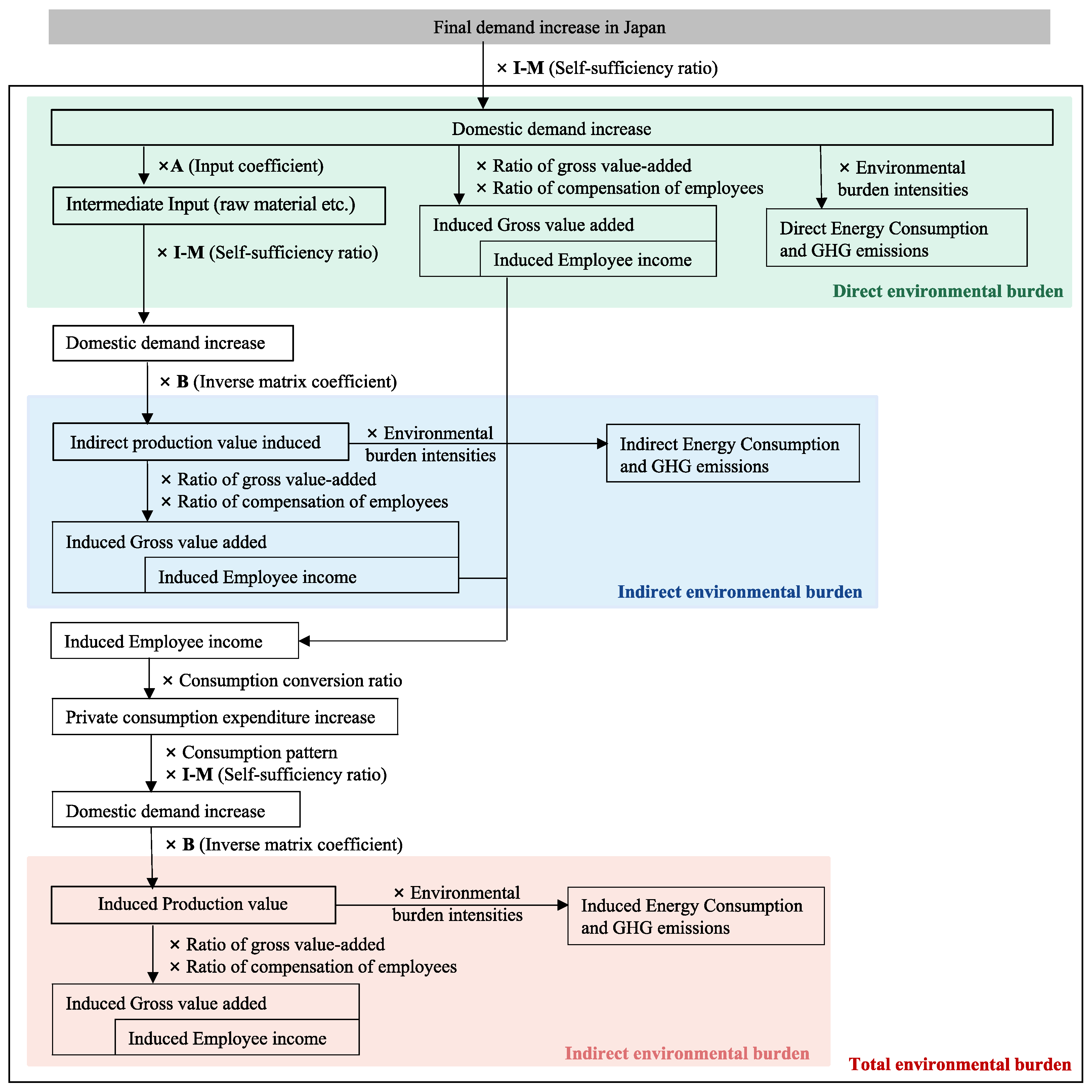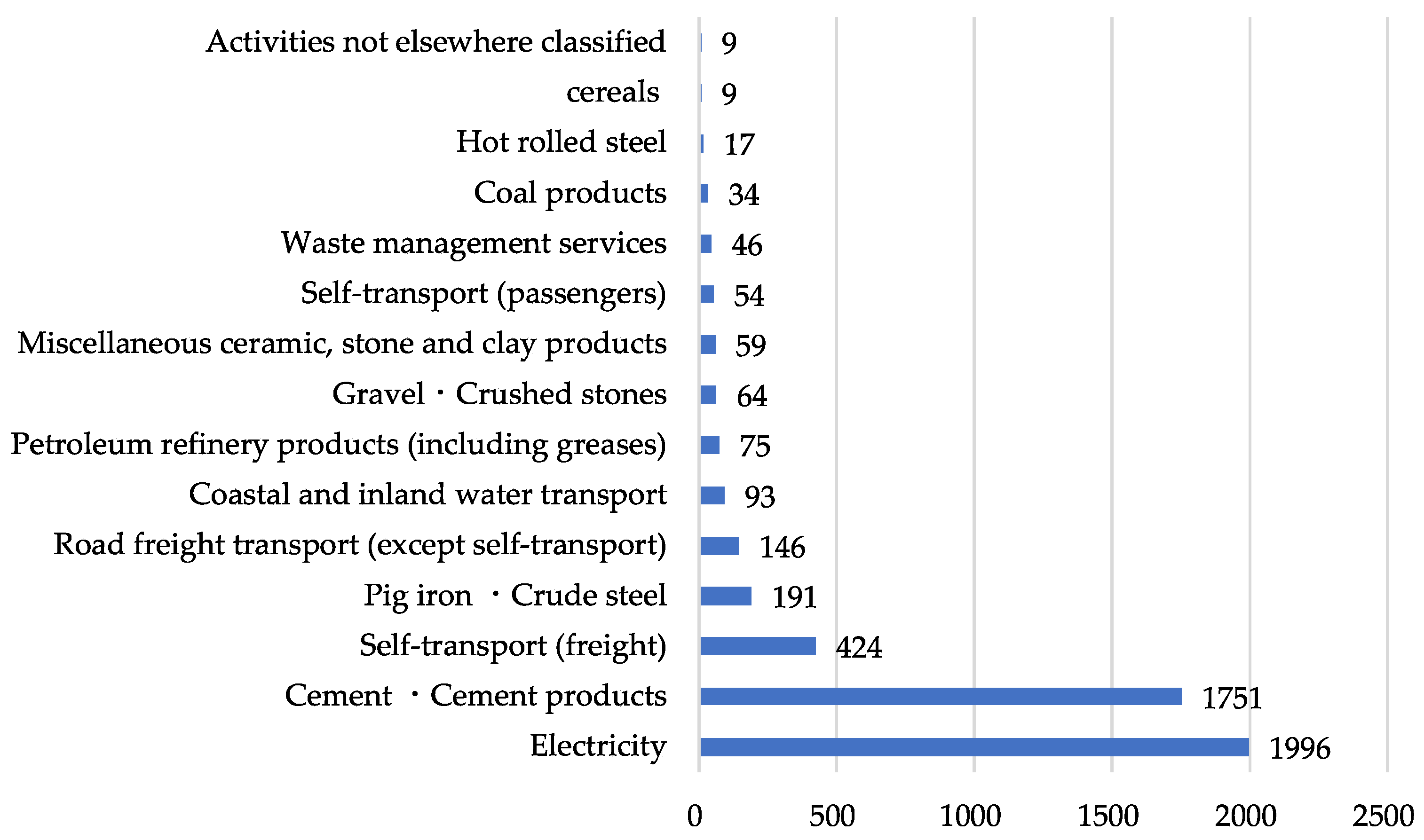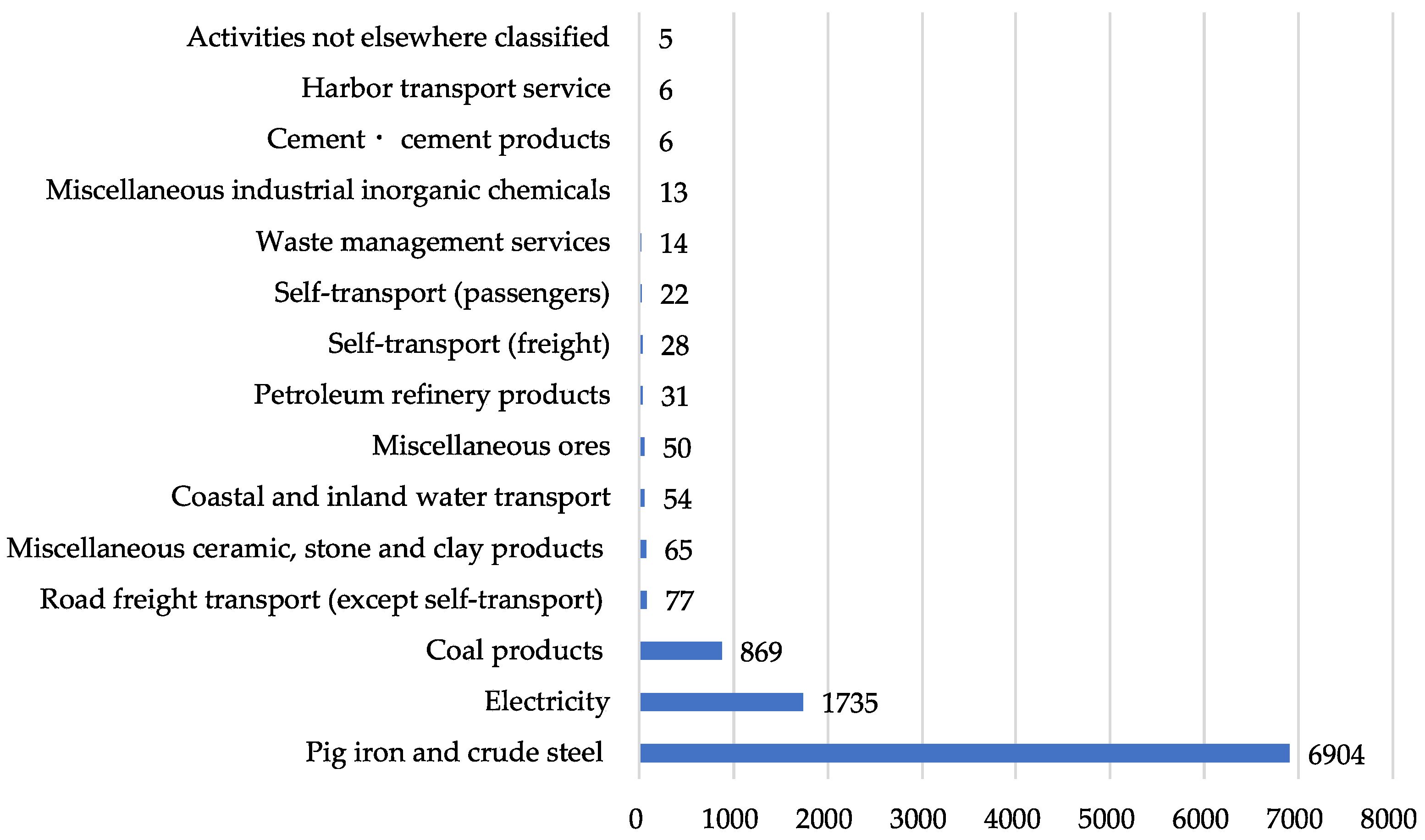Evaluation of the Environmental Burden of Cross-Laminated Timber Manufacturing in Japan Using the Input–Output Analysis
Abstract
:1. Introduction
2. Target and Methods
2.1. Target CLT Manufacturer
2.2. Evaluation Scope and Process Steps
2.3. Constructing the Basic Transaction Table
2.4. Domestic Self-Sufficiency Ratios
2.5. Evaluation of the Environmental Burden
3. Results
3.1. Environmental Burden of CLT Manufacturing
3.2. Environmental Burden of Cement and Steel Sectors
4. Discussions
4.1. Analysis of the Results
4.2. Comparison with Previous Studies
5. Conclusions
Author Contributions
Funding
Data Availability Statement
Acknowledgments
Conflicts of Interest
References
- United Nations. Paris Agreement. Available online: https://unfccc.int/files/essential_background/convention/application/pdf/english_paris_agreement.pdf (accessed on 12 December 2015).
- Emission Gap Report 2022: The Closing Window—Climate crisis calls for rapid transformation of societies. United Nations Environment Programme (UNEP). Available online: https://www.unep.org/resources/emissions-gap-report-2022 (accessed on 27 October 2022).
- 2020 Global Status Report for Buildings and Construction: Towards a Zero-Emissions, Efficient and Resilient Buildings, and Construction Sector-Executive Summary, Global Status Report 2020. United Nations Environment Programme, & Global Alliance for Buildings and Construction (2020). Available online: https://wedocs.unep.org/20.500.11822/34572 (accessed on 15 December 2020).
- Habert, G.; Miller, S.A.; John, V.M.; Provis, J.L.; Favier, A.; Horvath, A.; Scrivener, K.L. Environmental impacts and decarbonization strategies in the cement and concrete industries. Nat. Rev. Earth Environ. 2020, 1, 559–573. [Google Scholar] [CrossRef]
- Kylili, A.; Fokaides, P.A. Policy trends for the sustainability assessment of construction materials: A review. Sustain. Cities Soc. 2017, 35, 280–288. [Google Scholar] [CrossRef]
- Submission of Japan’s Intended Nationally Determined Contribution (INDC). Ministry of Foreign Affairs of Japan. Available online: https://www.mofa.go.jp/files/000090898.pdf (accessed on 17 July 2015).
- Trends in Forests and Forestry in FY2022. Ministry of Agriculture, Forestry and Fisheries of Japan. Available online: https://www.rinya.maff.go.jp/j/kikaku/hakusyo/r4hakusyo/attach/pdf/zenbun-41.pdf (accessed on 30 May 2023).
- Supply and Demand Table of Wood in 2020. Available online: https://www.rinya.maff.go.jp/j/press/kikaku/attach/pdf/210930-2.pdf (accessed on 30 September 2021).
- Japanese Agriculture Standard (JAS) 3079—Cross Laminated Timber. Available online: https://clta.jp/wp-content/uploads/2019/08/JAS3079-2019_CLT.pdf (accessed on 20 December 2013).
- New Road Map for the Diffusion of CLT. Available online: https://www.cas.go.jp/jp/seisaku/cltmadoguchi/pdf/r3_hontai.pdf (accessed on 20 September 2022).
- Hassan, O.A.B.; Öberg, F.; Gezelius, E. Cross-laminated timber flooring, and concrete slab flooring: A comparative study of structural design, economic and environmental consequences. J. Build. Eng. 2019, 26, 100881. [Google Scholar] [CrossRef]
- Huzita, T.; Sasaki, T.; Araki, S.; Kayo, C. Life cycle regional economic impacts of bridge repair using cross-laminated timber floor slabs: A case study in Akita Prefecture, Japan. Buildings 2022, 12, 158. [Google Scholar] [CrossRef]
- Shin, B.; Wi, S.; Kim, S. Assessing the environmental impact of using CLT-hybrid walls as a sustainable alternative in high-rise residential buildings. Energy Build. 2023, 294, 113228. [Google Scholar] [CrossRef]
- Duan, Z. Impact of climate change on the life cycle greenhouse gas emissions of cross-laminated timber and reinforced concrete buildings in China. J. Cleaner Prod. 2023, 395, 136446. [Google Scholar] [CrossRef]
- Andersen, J.H.; Rasmussen, N.L.; Ryberg, M.W. Comparative life cycle assessment of cross-laminated timber building and concrete building with special focus on biogenic carbon. Energy Build. 2022, 254, 111604. [Google Scholar] [CrossRef]
- Chen, Z.; Gu, H.; Bergman, R.; Liang, S. Comparative life-cycle assessment of a high-rise mass timber building with an equivalent reinforced concrete alternative using the Athena Impact Estimator for buildings. Sustainability 2020, 12, 4708. [Google Scholar] [CrossRef]
- Balasbaneh, A.T.; Sher, W. Comparative sustainability evaluation of two engineered wood-based construction materials: Life cycle analysis of CLT versus GLT. Build. Environ. 2021, 204, 108112. [Google Scholar] [CrossRef]
- Liu, Y.; Guo, H.; Sun, C.; Chang, W. Assessing cross laminated timber (CLT) as an alternative material for mid-rise residential buildings in cold regions in China—A life-cycle assessment approach. Sustainability 2016, 8, 1047. [Google Scholar] [CrossRef]
- Pierobon, F.; Huang, M.; Simonen, K.; Ganguly, I. Environmental benefits of using hybrid CLT structure in midrise non-residential construction: An LCA based comparative case study in the U.S. Pacific Northwest. J. Build. Eng. 2019, 26, 100862. [Google Scholar] [CrossRef]
- Nakano, K.; Koike, W.; Yamagishi, K.; Hattori, N. Environmental impacts of cross-laminated timber production in Japan. Clean Technol. Environ. Policy 2020, 22, 2193–2205. [Google Scholar] [CrossRef]
- Chen, C.X.; Pierobon, F.; Ganguly, I. Life cycle assessment (LCA) of cross-laminated timber (CLT) produced in Western Washington: The role of logistics and wood species mix. Sustainability 2019, 11, 1278. [Google Scholar] [CrossRef]
- Liu, M.; Huzita, T.; Murano, A.; Goh, C.S.; Kayo, C. Economic ripple effects analysis of cross-laminated timber manufacturing in Japan. Forests 2023, 14, 492. [Google Scholar] [CrossRef]
- MEIKEN LAMWOOD Corp. Available online: https://www.meikenkogyo.com/company/ (accessed on 25 March 2022).
- National Institute of Environmental Studies. 3EID. Available online: https://www.cger.nies.go.jp/publications/report/d031/jpn/datafile/index.htm (accessed on 22 November 2019).
- Isard, W.; Bassett, K.; Choguill, C.; Furtado, J.; Izumita, R.; Kissin, J.; Romanoff, E.; Seyfarth, R.; Tatlock, R. On the Linkage of Socio-economic and Ecologic Systems. Pap. Reg. Sci. 1968, 21, 79–99. [Google Scholar] [CrossRef]
- Leontief, W. Environmental repercussions and the economic structure: An input-output approach. Rev. Econ. Stat. 1970, 52, 262–271. [Google Scholar] [CrossRef]
- Lenzen, M.; Murray, S.A.; Korte, B.; Dey, C.J. Environmental impact assessment including indirect effects—A case study using input-output analysis. Environ. Impact Assess. Rev. 2003, 23, 263–282. [Google Scholar] [CrossRef]
- Ministry of Internal Affairs and Communications. 2015 Input-Output Tables for Japan, Explanatory Report. 2015. Available online: https://www.soumu.go.jp/main_content/000732915.pdf (accessed on 31 January 2021).
- Ministry of Internal Affairs and Communications. Input-Output Tables for Japan, Basic Transaction Tables (Producer Price Valuation) (Integrated Sub-Categories). 2015. Available online: https://www.e-stat.go.jp/stat-search/files?page=1&layout=datalist&toukei=00200603&tstat=000001130583&cycle=0&year=20150&month=0&stat_infid=000031839446&tclass1val=0 (accessed on 27 June 2019).
- Ministry of Internal Affairs and Communications. Input-Output Tables for Japan, Output Tables (Integrated Sub-Categories). 2015. Available online: https://www.e-stat.go.jp/stat-search/files?page=1&layout=datalist&toukei=00200603&tstat=000001130583&cycle=0&year=20150&month=0&stat_infid=000031839444&tclass1val=0 (accessed on 27 June 2019).
- Ministry of Internal Affairs and Communications. Input-Output Tables for Japan. Import Coefficients, Import Input Coefficients, Aggregate Import Coefficients, and Aggregate Gross Value Added Coefficients Table (Integrated Sub-Categories). 2015. Available online: https://www.e-stat.go.jp/stat-search/files?page=1&layout=datalist&toukei=00200603&tstat=000001130583&cycle=0&year=20150&month=0&stat_infid=000031839507&tclass1val=0 (accessed on 27 June 2019).
- Nansai, K. Methodology for Estimating Sectoral Energy Consumption and Greenhouse Gas Emissions Based on the 2005 Input-Output Table. 2013. Available online: https://www.cger.nies.go.jp/publications/report/d031/jpn/pdf/6/3EID2005_Method_jp.pdf (accessed on 8 August 2013).
- Ministry of Internal Affairs and Communications. Family Income and Expenditure Survey. Yearly Average of Monthly Receipts and Disbursements per Household (Workers’ Households of Total Households). 2020. Available online: https://www.e-stat.go.jp/statsearch/files?page=1&layout=datalist%toukei=00200561&tstat=000000330001&cycle=7&year=20200&month=0&tclass1=000000330001&tclass2=000000330019&tclass3=000000330021&stat_infid=000032106657&result_back=1&cycle_facet=tclass1%3Atclass2%3Atclass3%3Acycle&tclass4val=0 (accessed on 27 June 2019).
- United States Environment Agency. Greenhouse Emission Gas Data. Available online: https://www.epa.gov/ghgemissions/global-greenhouse-gas-emissions-data#:~:text=Carbon%20dioxide%20; Vol.CO2%3A,agriculture%2C%20and%20degradation%20of%20soils (accessed on 15 February 2023).
- World Nuclear Association. Carbon Dioxide Emissions from Electricity. Available online: https://www.world-nuclear.org/information-library/energy-and-the-environment/carbon-dioxide-emissions-from-electricity.aspx#:~:text=Worldwide%20emissions%20of%20carbon%20dioxide,and%20about%2020%25%20from%20gas (accessed on 27 October 2022).
- Puettmann, M.; Sinha, A.; Ganguly, I. Life cycle energy and environmental impacts of cross-laminated timber made with coastal doulglas-fir building. J. Green Build. 2019, 14, 17–33. [Google Scholar] [CrossRef]






| Materials and Expenditures | Sectors | |
|---|---|---|
| Intermediate Sector | Gross Value Added | |
| Material cost (lamina) | Timber | |
| Material cost (adhesive) | Miscellaneous final chemical products | |
| Material cost (some transportation costs) | Road freight transport (except self-transport) | |
| Salary allowance | Wages and salaries | |
| Excess work allowance | ||
| Bonuses | ||
| Legal welfare expenses | Consumption expenditure of households | |
| Welfare expenses | ||
| Freight | Road freight transport (except self-transport) | |
| Consumable expenses | Office supplies | |
| Vehicle-related expenses | Petroleum refinery products 40%, machine repair services 60% | |
| Rental expenses | Goods rental and leasing (except car rental) | |
| Insurance expenses | Insurance | |
| Repair expenses | Machine repair services | |
| Fuel expenses | Petroleum products | |
| Utility expenses | Electricity 94%Steam and hot water supply 5%Water supply 1% | |
| Packaging | Packaging | |
| Tax and rent | Indirect taxes (except custom duties and commodity taxes on imported goods) | |
| Travel and transportation expenses | Consumption expenditure of households | |
| Depreciation and amortization | Consumption of fixed capital | |
| Small depreciable assets | ||
| Lump-sum depreciable assets | ||
| Storage charges | Storage facility service | |
| Communication expenses | Communications | |
| Business fees | Miscellaneous business services | |
| Security and cleaning expenses | Wages and salaries | |
| Recruitment and training expenses | ||
| Meeting expenses | Office supplies | |
| Allocation to other departments | Wages and salaries | |
| Expense transfer (dry steam, etc.) | Activities not elsewhere classified | |
| CO2 (Energy Origin) (t-CO2) | CO2 (non-Energy Origin) (t-CO2) | CH4 (t-CO2eq) | N2O (t-CO2eq) | HFCs (t-CO2eq) | PFCs (t-CO2eq) | SF6 (t-CO2eq) | NF3 (t-CO2eq) | Total GHG Emission (t-CO2eq) | Total Energy Consumption (GJ) | |
|---|---|---|---|---|---|---|---|---|---|---|
| Direct | 1057 | 2 | 1 | 6 | 0 | 0 | 1 | 0 | 1066 | 17,123 |
| Indirect | 1859 (287) | 53 (11) | 8 (15) | 16 (8) | 10 (2) | 0 (0) | 1 (0) | 0 (0) | 1948 (322) | 29,560 (4661) |
| Total | 3202 | 66 | 24 | 30 | 12 | 1 | 2 | 0 | 3336 | 51,344 |
| CO2 (Energy Origin) (t-CO2) | CO2 (non-Energy Origin) (t-CO2) | CH4 (t-CO2eq) | N2O (t-CO2eq) | HFCs (t-CO2eq) | PFCs (t-CO2eq) | SF6 (t-CO2eq) | NF3 (t-CO2eq) | Total GHG Emission (t-CO2eq) | Total Energy Consumption (GJ) | |
|---|---|---|---|---|---|---|---|---|---|---|
| Direct | 5845 | 8977 | 6 | 15 | 0 | 0 | 0 | 0 | 14,843 | 66,522 |
| Indirect | 3626 (10) | 1160 (13) | 10 (7) | 25 (2) | 12 (0) | 0 (0) | 2 (0) | 0 (0) | 4836 (196) | 54,008 (263) |
| Total | 9481 | 10,151 | 23 | 42 | 12 | 1 | 2 | 0 | 19,975 | 120,794 |
| CO2 (Energy Origin) (t-CO2) | CO2 (Non-Energy Origin) (t-CO2) | CH4 (t-CO2eq) | N2O (t-CO2eq) | HFCs (t-CO2eq) | PFCs (t-CO2eq) | SF6 (t-CO2eq) | NF3 (t-CO2eq) | Total GHG Emission (t-CO2eq) | Total Energy Consumption (GJ) | |
|---|---|---|---|---|---|---|---|---|---|---|
| Direct | 11,571 | 556 | 11 | 12 | 0 | 0 | 0 | 0 | 12,161 | 115,293 |
| Indirect | 9451 (85) | 427 (3) | 16 (4) | 27 (2) | 4 (1) | 0 (0) | 2 (0) | 0 (0) | 9893 (95) | 105,336 (1379) |
| Total | 21,072 | 987 | 32 | 52 | 5 | 0 | 2 | 0 | 22,149 | 222,008 |
Disclaimer/Publisher’s Note: The statements, opinions and data contained in all publications are solely those of the individual author(s) and contributor(s) and not of MDPI and/or the editor(s). MDPI and/or the editor(s) disclaim responsibility for any injury to people or property resulting from any ideas, methods, instructions or products referred to in the content. |
© 2023 by the authors. Licensee MDPI, Basel, Switzerland. This article is an open access article distributed under the terms and conditions of the Creative Commons Attribution (CC BY) license (https://creativecommons.org/licenses/by/4.0/).
Share and Cite
Liu, M.; Murano, A.; Goh, C.S.; Kayo, C. Evaluation of the Environmental Burden of Cross-Laminated Timber Manufacturing in Japan Using the Input–Output Analysis. Forests 2023, 14, 2263. https://doi.org/10.3390/f14112263
Liu M, Murano A, Goh CS, Kayo C. Evaluation of the Environmental Burden of Cross-Laminated Timber Manufacturing in Japan Using the Input–Output Analysis. Forests. 2023; 14(11):2263. https://doi.org/10.3390/f14112263
Chicago/Turabian StyleLiu, Mengyuan, Akito Murano, Chun Sheng Goh, and Chihiro Kayo. 2023. "Evaluation of the Environmental Burden of Cross-Laminated Timber Manufacturing in Japan Using the Input–Output Analysis" Forests 14, no. 11: 2263. https://doi.org/10.3390/f14112263
APA StyleLiu, M., Murano, A., Goh, C. S., & Kayo, C. (2023). Evaluation of the Environmental Burden of Cross-Laminated Timber Manufacturing in Japan Using the Input–Output Analysis. Forests, 14(11), 2263. https://doi.org/10.3390/f14112263





